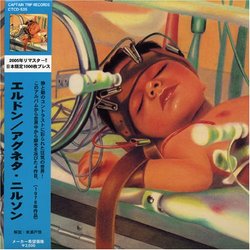With their fourth album Heldon defines their style
Micah R. Sisk | Frederick, MD USA | 04/18/2001
(5 out of 5 stars)
"Heldon's fourth album, subtitled Agneta Nilsson, was originally released in 1976 and was the first Heldon recording to fully capture the band's style. All three previous releases were either hints at where the band would go or investigations of the music that influenced the band. None until Agneta Nilsson were solidly and clearly Heldon. And yet, as perhaps all their works do, this CD contains many references to the types of music the band had created up till this point and to the music from which Heldon was drawn.Superbly crafted to take you on a journey through Heldon-land, Agneta Nilsson begins with Perspective I, a slow, dark, spacey synthesizer soundscape somewhat reminiscent of other 70s analog composers--an extremely slow J.M. Jarre piece, perhaps--but has all the classic hallmarks of Heldon's mature sound. Next up, Perspective II is a rather abstract piece which builds its base on shimmering, quivering sequencer warbles overtop of which are sprinkled distant gongs, cymbals and various percussive sounds. There are songs on Heldon I and III that foreshadow this piece but none of them are as congealed in compositional intent or execution. "Perspective III (Baader-Meinhof Blues)" is a classic Heldon electronic assault, as one might guess from the title, referring as it does to the terrorist-organization-of-the-decade. It marries a fast paced Tangerine Dream-ish bass synthesizer sequence with synthesizer effects and a truly blistering distorted guitar improvisational solo. But the Dream was never this knife-edged and Froese was never this wicked on the guitar. After Perspective III we get a well-deserved rest and a complete change-up. Bassong, the only song on this CD not to have been written by Richard Pinhas, harkens back to Heldon's second release, Allez Teia but it also heads off into new territory. The underpinning of this song is a gentle guitar arpeggio but it is the bass gutiar which takes the lead and harmony lines. Bass as a lead instrument was very new in the 1970s, coming from the jazz fusion world that had percolated up to the surface by the time this album was recorded. The effect is not un-Heldon like but it does sound a lot like other works of the time by artists such as Phil Manzenera (reference his Quiet Sun, Mainstream album). Perspective IV finishes the CD. It's a huge piece that begins as a lush exercise in Frippesque guitar work and then morphs into a recap of Perspective II before transforming again into an extended drums/bass/guitar jam with King Crimson overtones and pitch-bending minimoog melodies. Quite strangely--because it works so well--this piece ends with another transformation; a bass sequencer line sneaks in and takes over, sounding at first very much like Tangerine Dream. In retrospect, however, this bass line has more in common with the repetitive bass lines used in Philip Glass's compositions of this same time. Overtop this bass is a percussion improve tour-du-force complete with freaky effects and a startling cliff ending.For fans of progressive rock and electronic music, this CD offers a varied and satisfying blend of moods and styles, while at the same time congealing into a logical and rewarding whole. Heldon hit their stride with this album and I find it well worth a listen."


 Track Listings (5) - Disc #1
Track Listings (5) - Disc #1